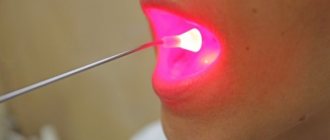What is sinusitis and its possible complications
Sinusitis is a diagnosis given to people who have inflammation of the paranasal sinuses. The reasons for its occurrence can be varied:
- penetration of a bacterial or viral infection into the nasal cavity;
- complications after colds;
- diseases of the upper molars;
- allergy.
Headaches with sinusitis, chills and difficulty breathing through the nose are the main symptoms of this disease. In addition, patients often complain of general weakness, increased body temperature, swelling and redness of the eyelids.
The greatest danger is hidden sinusitis, when its symptoms are not invisible and are similar to ordinary fatigue.
Inflammation of the maxillary sinuses is not a harmless disease. The organs and tissues located in close proximity to the lesion are most susceptible to complications. Untimely or unqualified treatment can lead to:
- purulent lesions of the bones of the upper jaw;
- diseases of the organs of vision: swelling of the tissue and thrombosis of the veins of the orbit, damage to the optic nerve;
- brain damage: meningitis, less commonly, meningoencephalitis;
- complications from internal organs: heart, liver, kidneys, respiratory organs.
The greatest danger is brain damage, which requires the fastest possible decision-making - unfortunately, death from sinusitis in this case is not uncommon.
Consequences of sinusitis in adults and children
The most dangerous thing about sinusitis is not the disease, but its consequences. In the absence of adequate therapy, the pathology is aggravated by hyperthermia and inflammatory infiltration of the orbital tissue. Everything comes with intoxication. The problem of sinusitis and its consequences goes beyond otorhinolaryngology. It is closely related to changes in local and humoral immunity, allergization of the body, and bronchopulmonary pathology.
Chronic sinusitis
Chronic inflammation of the maxillary sinuses is considered a complication of an untreated acute process. Occurs when the outflow of accumulating pathological secretions is disrupted. Provoking factors: enlargement (hypertrophy) of shells; thickening of the nasal mucosa; deviation of the nasal septum in both or one direction from the midline. During the period of the disease, which occurs with exacerbations, signs of acute sinusitis are observed. Remission is characterized by periodic purulent discharge from the nose, swelling of the eyelids in the morning, pain in the eye sockets, and a persistent decrease in the sense of smell. The disease is not often diagnosed in early childhood. It occurs under the guise of osteomyelitis of the upper jaw. It is aggravated by severe complications - purulent fistulas, necrosis of soft tissues of the face, bones of the facial skeleton.
Important! In older children, the course of sinusitis is identical to its symptoms in adults. At the slightest suspicion of inflammation of the nasal sinuses in a child, parents should not waste time and seek help from an otolaryngologist.
Respiratory complications
The infectious process of sinusitis spreads to the trachea, lungs and bronchi, causing complications of various diseases. Symptoms of asthma and other chronic lung diseases intensify, and their ventilation function is impaired. Sometimes bronchitis and pneumonia, and a dry cough develop against the background of sinusitis.
Cough after sinusitis also indicates the transition of the disease to a chronic form. It occurs due to the outflow of pus from the affected nasal sinuses along the back wall of the pharynx. Most often it disturbs at night and does not respond to treatment.
Inflammation of the trigeminal nerve
The consequences of sinusitis include inflammation of the trigeminal nerve. I am worried about severe paroxysmal pain in the face. The attacks are one-sided, shooting, lasting from several seconds to 2 minutes. Painful sensations spread to the temporal, frontal region, and teeth of the upper jaw. During treatment, consultation with a neurologist is required.
Inflammation of bone tissue
The purulent process can destroy the walls of the maxillary sinus, penetrate into the bone tissue, and cause inflammation. An extremely rare complication from sinusitis is osteomyelitis of the upper jaw bone.
Blood poisoning sepsis
The anatomical features of the structure of the maxillary sinus and the proximity of vital organs favor the development of rhinogenic sepsis. The pathological symptom complex is caused by the entry of microorganisms into the blood from the focus of purulent inflammation. It is relatively rare. The consequences of sinusitis in this case are manifested by intracranial complications. The introduction of bacteria and toxins into the meninges causes purulent meningitis, meningoencephalitis, and epidural abscess.
Visual impairment, osteoperiostitis
The close location of the nose to the tissues of the orbit and cranial cavity affects the formation of ophthalmological and intracranial complications. In some cases, orbital complications are diagnosed in patients with both acute and chronic sinusitis. The clinic depends on the location of the lesion.
When the sinuses become inflamed, osteoperiostitis can develop. Sinusitis is not often its cause. If it occurs, it is manifested by redness, swelling of the lower eyelid, and swelling of the cheek. Purulent osteoperiostitis is expressed by fever, asthenia, and headache. Due to swelling of the retrobulbar tissue and optic neuritis, visual acuity may decrease to the point of blindness.
Damage to internal organs
Sinusitis is a disease that causes inflammation not only in the maxillary sinuses, but also causes damage to internal organs. This is a focal point of infection, which is accompanied by chronic intoxication of the body. Violation of nasal breathing causes a change in blood composition, acceleration of ROE, a decrease in the amount of hemoglobin, and an increase in calcium.
Otitis
Sinusitis can cause inflammation in the ear. When blowing your nose incorrectly, bacteria penetrate through the auditory tube into the middle ear, less often through the hematogenous route. The inflammation occurs as catarrhal or purulent otitis media. It manifests itself as painful lumbago in the ear and high fever. In advanced cases - purulent discharge from the ear canal.
Complications on the brain and spinal cord
Among the rhinogenic intracranial complications of sinusitis, secondary purulent meningitis is dangerous. In second place are abscesses of the brain and cerebellum, in third place are thrombosis of the cavernous sinus and sepsis. Damage to the central nervous system affects all levels of the human body, causing consequences that often lead to death. A rare rhinogenic complication is spinal cord arachnoiditis.
Complications during pregnancy
Inflammation of the paranasal sinuses during pregnancy is a consequence of an untreated viral infection. Pregnant women often neglect treatment, fearing for the health of the unborn child. But a purulent focus is a danger to both the mother and the fetus. Why is sinusitis dangerous?
Difficulty in nasal breathing in a woman leads to a lack of oxygen in the fetus. This can negatively affect the rate of development and cause changes in the brain. Intrauterine bacterial infection is the cause of neurological diseases in a child.
Complications after puncture in the treatment of sinusitis
Complications and consequences of sinusitis after puncture of the maxillary sinus are sometimes the result of insufficient experience of the doctor. Explained by anomalies in the thickness and location of the bone walls. The most common are infiltration, emphysema of the soft tissues of the cheek or the tissue of the orbit and eyelids. The development of phlegmonous inflammation, which sometimes ends in sepsis, cannot be ruled out.
The adverse effects of punctures often include bleeding caused by damage to blood vessels. Complications also include air embolism and temporary visual impairment.
Sinusitis is a source of infection. Disturbs the morpho-functional state of the upper respiratory tract. It is considered a dangerous disease for the health and sometimes even the life of patients.
What do you need to know about the disease?
Sinusitis is a pathological condition that is manifested by the occurrence of an infectious-inflammatory process in the mucous membrane of the maxillary sinuses. Any infectious process can not only spread to neighboring tissues, but also penetrate into the blood and spread throughout the body through the bloodstream, which provokes the appearance of foci of the infectious process at a distance from the main site of localization.
The occurrence of sinusitis and its progression can occur for a variety of reasons, the most common of which are the following:
- injuries to the nasal mucosa;
- viral and bacterial infections entering the nasopharynx;
- colds;
- drafts;
- negative effects of chemical elements on the mucous membrane of the respiratory tract;
- advanced dental pathologies;
- hypothermia of the body;
- weak immunity;
- nasal polyposis;
- adenoids;
- violation of the functional characteristics of the secretory glands;
- allergy.
An advanced inflammatory process in the mucous membrane of the maxillary sinuses can provoke the development of serious consequences. The question of whether it is possible to die from sinusitis worries many patients suffering from a chronic form of the pathology. This is due to the fact that the brain is located next to the nasal cavity, damage to which by a bacterial infection can lead to the development of meningitis.
There are several forms of the disease, each of which has differences in the course and treatment tactics used.
Doctors distinguish the following types of inflammatory process, depending on the nature of the pathogenic factors that provoked the disease:
Before prescribing drug therapy, the doctor determines the nature of the pathogenic factors in order to select the correct treatment regimen and select the means for administering the drug. Carrying out drug therapy for an infectious-inflammatory process on the mucous membrane of the paranasal sinuses requires the use of various medications.
To reduce swelling, short-acting vasoconstrictors are used - Nazol, Naphthyzin, Xylene. To destroy pathogenic flora, antibacterial agents are used - Isofra, Protargol and some other antibiotics.
To increase the activity of the immune system and counteract viral infection, immunomodulatory and antiviral drugs are prescribed. Such drugs are represented by Interferon, Grippferon, Derinat and some others.
In case of sinusitis development due to allergies, pharmacological drugs with antihistamine properties are used for treatment. Such drugs can be either hormonal or non-hormonal. They are used to relieve allergic swelling. The most popular are Nasonex, Avamis, Sanorin, Allergodil and others.
To enhance the effect of drugs used in complex drug therapy, it is recommended to use inhalations with the addition of essential oils of medicinal plants. Such physiotherapeutic procedures have an antimicrobial effect on the patient’s body.
You can use homeopathic methods for therapeutic measures, but before using them it is recommended to consult with your doctor who is supervising the therapy.
Complications after sinusitis
Sinusitis itself poses a serious threat to human health. Due to the development of inflammation, the mucous membrane of the maxillary sinuses and the inside of the nose swells. The patient has difficulty separating mucus from the maxillary cavities, and nasal breathing becomes difficult. Accumulations of mucus are a favorable environment for the existence and reproduction of viruses and bacteria. A further increase in the number of pathogenic microorganisms leads to an even greater development of the inflammatory process in the mucous membrane of the maxillary sinuses and the accumulation of mucus in them. This creates a vicious circle in the maxillary sinuses, which causes the development of complications of sinusitis.
Complications associated with the respiratory system and ENT organs
The most common complications of sinusitis develop:
- Transition from an acute form of a disease to a chronic form . Acute sinusitis becomes chronic as a result of untimely treatment, weak immunity, failure to follow doctor’s recommendations, and the presence of chronic diseases of the ENT organs. In addition, severe pathology of the respiratory and cardiovascular systems, in which the patient experiences shortness of breath and hypoxia (oxygen deficiency), contributes to the chronicity of sinusitis. Symptoms of complications of sinusitis when it passes into the chronic stage are constant headache of moderate intensity, nasal voice, pain in the maxillary sinuses. The patient usually breathes through his mouth, since nasal breathing is difficult.
- Inflammatory processes in the tonsils and pharynx (tonsillitis, polyps, adenoids). Constantly existing inflammation of the mucous membrane of the nasal passages contributes to its hypertrophy (thickening). Complications after sinusitis can be polyps - benign tumor-like neoplasms that form on the mucous membrane of the nasal passages. At the same time, they further complicate nasal breathing, leading to further swelling of the mucous membrane. Also, tonsils are exposed to an infectious-inflammatory process during sinusitis, which causes the development of sore throat.
- Development of bronchitis and pneumonia . With downward spread, the infection from the maxillary sinuses penetrates the trachea, bronchi, and lungs. The patient suffers from frequent bronchitis and pneumonia. Pleuropneumonia may appear (the inflammatory process also extends to the pleura). Symptoms of complications of sinusitis with the development of pneumonia include signs of respiratory failure and intoxication of the body. Frequently recurring bronchitis is dangerous due to the possibility of developing bronchial asthma.
- Sinusitis . The maxillary, frontal, sphenoid, and ethmoid sinuses communicate with each other through the nasal passages. This explains the fact that when inflammation appears in one of them, others are gradually involved in the pathological process. In particularly serious cases, inflammation can affect all cavities (sinuses). But usually complications after sinusitis are inflammation in the ethmoidal (ethmoidal) and frontal (frontal) cavities.
- Otitis . Pathogenic microorganisms penetrate from the maxillary sinuses into the ear through the pharynx and Eustachian tube and otitis media develops. Symptoms of complications of sinusitis in this case include ear congestion and pain. The pain syndrome gradually becomes more intense, it intensifies at night. Later, purulent discharge from the ear canal joins these symptoms.
Pathological conditions affecting distant human organs and systems
Sometimes the patient develops a dangerous complication of the disease – meningitis. Typically, meningitis is a continuation of the development of otitis, in which the purulent process affects the meninges. Symptoms of complications of sinusitis in this case may include high body temperature and severe headache. Then the patient develops neurological signs with partial loss of consciousness.
In some cases, complications of sinusitis may include damage to distant tissues and organs of the patient. Most often the myocardium (heart muscle), joints, and kidneys are affected.
The most dangerous complication of inflammation of the maxillary sinuses is sepsis (blood poisoning). This condition can be fatal.
Sinusitis and bad habits
The manifestation of the disease indicates weakening of health, indicating a decrease in the protective functions of internal organs.
Violations can be caused by poor nutrition and bad habits - smoking, alcohol, drugs, etc.
And even banal ignoring of rhinitis, since modern methods of treating the latter prevent the development of inflammatory processes in other organs and tissues.
A habit such as smoking contributes to the progression of acute sinusitis into chronic - and against this background, the development of cancerous tumors is quite possible. Alcohol dilates blood vessels, making it easier for the source of infection to enter the bloodstream.
If you abuse alcohol, drugs against sinusitis are powerless - and the risk that infection will cause sepsis in the blood increases sharply.
If adequate treatment of sinusitis is constantly delayed, and the patient prefers dubious methods of traditional medicine, the consequences can be serious complications, which, in turn, can lead to death.
Complications on the visual organs
The eyes are most often affected by sinusitis. The prevalence of consequences for vision is associated with the ever-increasing volume of viruses and modifications of bacteria that lead to the development of the original disease.
See also
How the puncture procedure is done for sinusitis, possible consequences and what to do next
Read
In most cases, inflammatory processes in the eyes are caused by an infection of the ethmoid labyrinth that accompanies sinusitis. It is characteristic of the chronic form of the disease in adults. In a child, complications in the eyes can be caused by the acute form.
The infection penetrates the organs of vision through the circulatory system or by contact. As a result, orbital tissue is damaged. Swelling develops on the eyelids, cheeks, touching the eyes and upper part of the face becomes painful. In some cases, purulent discharge appears.
In the case of a non-purulent lesion, a number of symptoms are noted:
- restriction of eye mobility;
- swelling of the conjunctiva;
- displacement of the eyes forward or to the side;
- inflammation of the optic nerve.
Lack of treatment leads to deterioration of vision, development of diplopia, and neuritis.
When suppuration occurs, there is a high temperature, chills, vomiting, increased ESR, and intoxication of the body. Lack of therapy leads to abscess of the eyelids and orbital tissue, and the appearance of phlegmon.
Additional factors aggravating the disease
The disease is aggravated by bad habits and errors in treatment. It is customary to identify the following factors that contribute to the transformation of sinusitis into frontal sinusitis:
- Tobacco smoke, when passing through the nasal passage, contaminates mucus residues in the sinuses and reduces their mobility when removed outside. Stagnation of mucus leads to inflammation in the sinuses and the development of pathogenic microflora in an infected environment. The process of smoking causes complications of sinusitis, sometimes leading to cancer in the paranasal sinuses.
- Drinking alcohol causes blood vessels to dilate. In sinuses prone to runny nose, swelling increases and the breathing process becomes more difficult. In addition, when intoxicated, antibiotic drugs that help the body fight inflammation in the nasal cavity stop working.
- Disturbances in the treatment process. Medical recommendations for patients are not followed, the treatment course has not been completed. Sometimes, the patient voluntarily replaces prescribed medications with cheaper analogues. Or it stops being treated when the symptoms of the disease disappear, although the cause of sinusitis itself has not been eliminated.
- Incorrect, too intense blowing of the nose leads to the fact that purulent formations move into the inner ear.
Complications from sinusitis arise for various reasons. It is worth first curing the disease, and then returning to the usual rhythm of everyday life.
Important! Having been diagnosed with sinusitis, it is better not to abuse bad habits in order to avoid worsening the condition.
Other complications of sinusitis that are life-threatening
In addition to bad habits and an unhealthy lifestyle, the development of certain complications can be triggered by insufficient blood supply to the brain, which occurs with atherosclerosis and some other diseases.
Based on the risk to life, the following complications of sinusitis can be distinguished:
- infection of the organ of vision - damage can occur as a result of prolonged purulent sinusitis;
- purulent inflammatory processes in the bones of the upper jaw;
- damage to the cardiovascular and genitourinary systems;
- diseases of the respiratory system and liver.
Alarming symptoms of sinusitis, signaling the development of serious complications, can be considered:
- severe pain in the neck and various parts of the face;
- hearing impairment;
- swelling of the face, accompanied by constant pain;
- the appearance of conjunctivitis;
- swelling of the eyelids;
- blurred vision;
- inability to distinguish taste.
Even one of the listed manifestations indicates symptoms of a disease that has serious consequences. Therefore, a person should immediately seek help from doctors. The first thing you can do is visit an otolaryngologist.
Intracranial complications
If sinusitis is not treated in a timely manner, the pathology can lead to various types of pathologies. Intracranial complications of sinusitis occur quite rarely, however, one should not forget about the existing danger. Such a pathology can develop into meningitis, which is characterized by an inflammatory process of the membranes of the brain. This is especially dangerous if the pathology occurs in children.
With sinusitis there may be complications such as:
- sinus thrombosis;
- purulent meningitis;
- brain abscess.
Many people are interested in what will happen if sinusitis is not treated in a timely manner. If timely therapy is not carried out, the risk of complications will only increase significantly, which is accompanied by an increase in the intensity of the headache.
We won't abandon you
Firstly, even severe sinusitis, if treated correctly and carefully, will not become chronic. In the case of primary sinusitis, one well-chosen and correctly carried out course of treatment is enough (the average duration of such a course is 10 days) to finally get rid of the disease.
Even if you have practically forgotten how to breathe without vasoconstrictor drops (the so-called “galazolin addiction”), a special radio wave thermal reduction technique developed in our clinic will free you from this habit (leading, by the way, to psychological dependence on the drug and high blood pressure) and return You are able to breathe without the help of medications.
Secondly, various home remedies will only make you feel psychologically better - believe me, doctors have enough experience to say so. Thirdly, if you need a puncture, make sure for yourself that it is not painful or scary. It is significant that children and adolescents, from whom their parents decide to hide the name of the upcoming manipulation, have no idea that they have undergone “the same puncture” - because anesthesia in our clinic is selected individually, taking into account all the characteristics of the patient.
Causes
Sinusitis most often occurs due to the penetration of viruses and pathogenic bacteria into the nasopharynx. If a person's immune system is weakened for any reason, there is also a high probability of developing a disease.
There are other possible factors that provoke the appearance of the inflammatory process:
- Damage to the mucous membrane of the maxillary sinuses.
- A cold that has not been completely cured.
- Influenza virus.
- Spending a long time in the cold or draft.
- Physical impact on the nasal septum or trauma.
- Infection of the mucous membrane by one of the types of fungus.
The main cause of the disease must be determined by the attending physician after examining the patient and studying test results. In some cases, it is impossible to do without surgery, because the lack of treatment can lead to dire consequences.
Symptoms
Symptoms of advanced sinusitis are the following:
- constant nasal congestion, yellow-green discharge mixed with pus;
- headaches that cannot be relieved with strong painkillers;
- increased body temperature (above 38 degrees);
- weakness, chills;
- swelling of the face.
Many people do not know how to determine the stage of sinusitis. In advanced forms, exacerbations can be replaced by remissions and begin again with even greater force.
Under no circumstances should you take your health lightly. Self-medication and traditional medicine are definitely not helpful here - they can only aggravate the situation. Only a doctor can prescribe treatment after examining the patient and carrying out the necessary procedures. Sinusitis differences by type:
- Viral sinusitis, which is characterized by inflammation, is a consequence of an acute respiratory viral infection, and often occurs without purulent discharge.
- Bacterial sinusitis occurs in a purulent form, there is a specific smell of discharge, body temperature rises to forty degrees, chills and fever appear.
- Fungal sinusitis is not common; the form immediately becomes chronic, most often due to a weakened immune system or taking antibiotics.
- Allergic sinusitis is caused by some allergen and is manifested by severe swelling of the sinuses, nasal congestion, and copious mucus secretion.
Different types of diseases are treated according to a regimen determined by the doctor.
Treatment must be supplemented with the exception of:
- smoking, increases the chances of getting a chronic form of sinusitis;
- drinking alcohol, blood vessels dilate, which leads to the release of infection into the blood and rapid spread throughout the body, and antibiotics taken with alcohol will reduce the effect several times;
- taking drugs.
We reduce the risks of complications
In order to prevent sinusitis from occurring in an advanced form, it is necessary to begin treatment correctly and on time. Only those selected according to an individual scheme will be beneficial and will help the patient recover quickly. No amateur performances! Traditional methods can be used only after consultation with a doctor, if this does not harm the body. You should not overheat or overcool the body during illness.
By following some rules, you can reduce the risk of sinusitis and the consequences of an advanced form:
- treat a runny nose in a timely manner;
- visit the dentist once every six months to monitor your dental health;
- strengthen the immune system with proper nutrition, morning exercises and hardening;
- during viral epidemics, stay away from large crowds of people;
- correct a crooked septum, if necessary.
Massage and physiotherapy have a good effect. During the massage, blood circulates in the sinuses, a feeling of warmth and heating appears in the area being massaged, which has a beneficial effect on the entire circulatory system and helps remove congestion in the paranasal sinuses.
The answer to the question “can you die from sinusitis” is obvious. You should take care of yourself and consult a doctor at the first symptoms.
So is it possible to die from sinusitis?
To summarize, it is impossible not to mention that you can actually die from sinusitis if you do not start treating the disease in time.
The infection spreads throughout the body, enters the brain, and inflammatory processes begin, which leads to the development of meningitis and other dangerous diseases. In the most severe cases, the patient experiences severe convulsions, falls into a coma, and dies.
It is worth sounding the alarm if, as a result of illness, a person begins to experience unbearable headaches, loses consciousness, does not recognize the people around him, and his personality completely changes.
The disease can also cause purulent inflammation of the upper jaw, infection of the organs of vision or hearing, swelling of the face, loss of taste and many other complications that will require additional treatment. The chronic course of the disease can also lead to death, so direct all your efforts to finally cure sinusitis with the help of available medications.
In severe cases of the disease, the patient is sent to hospital treatment
However, you should not be afraid of all this if sinusitis is diagnosed at the very beginning of its occurrence.
It is necessary to make an appointment with an ENT specialist, undergo an examination and pass the appropriate tests. After this, strictly follow all the doctor’s recommendations and undergo full treatment of the disease.
In this case, not only do you not need to fear death, but there will also be no serious complications.
Article rating:
(35.00 out of 5)Loading…
What is sinusitis
Sinusitis is an inflammatory process of the maxillary sinuses. Any infection has the ability to spread not only to adjacent tissues, but also to penetrate the bloodstream, causing the development of foci of infection in remote areas, or to affect the entire body at once.
Important. About 4-6 million people die annually from sepsis, which is from 10 to 15% of all patients, from meningitis - about 20% of all infected, 80% of them in the first 24 hours from the moment the infection develops. These are the 2 main complications that make sinusitis fatal, but they are not the only ones.
Sinusitis becomes deadly only if proper treatment is not started in time. With a timely diagnosis and early contact with an otolaryngologist, it is completely cured, leaving no changes in the body. If treated late, when the process has become chronic, it can cause relapses of the disease if the factors are unfavorable for the patient, but it is completely curable in the absence of severe complications.
Consequently, you can die from sinusitis, but only if you neglect your health and self-medicate with methods inappropriate for this disease. It should be borne in mind that sinusitis comes in different types and can be:
- viral,
- bacterial,
- fungal,
- allergic nature.
Each of these forms has a different treatment, but a similar clinical manifestation. Only a doctor can prescribe adequate therapy after making an accurate diagnosis, which is possible with a full examination.









